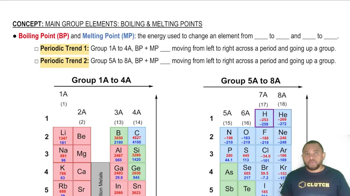Here are the essential concepts you must grasp in order to answer the question correctly.
Melting Point
The melting point of a substance is the temperature at which it transitions from a solid to a liquid. It is influenced by the strength of the intermolecular forces present in the solid. Stronger forces typically result in higher melting points, as more energy is required to overcome these interactions.
Recommended video:
Boiling Point and Melting Point
Intermolecular Forces
Intermolecular forces are the forces of attraction or repulsion between molecules. They include hydrogen bonding, dipole-dipole interactions, and London dispersion forces. The type and strength of these forces significantly affect the physical properties of substances, including their melting points.
Recommended video:
Intermolecular vs Intramolecular Forces
Ionic vs. Molecular Solids
Ionic solids, like LiCl, consist of ions held together by strong electrostatic forces, resulting in high melting points. In contrast, molecular solids, such as CCl4 and CH3OH, are held together by weaker intermolecular forces. Understanding the distinction between these types of solids is crucial for predicting their melting behavior.
Recommended video:
Crystalline vs Amorphous Solids
 Verified step by step guidance
Verified step by step guidance


